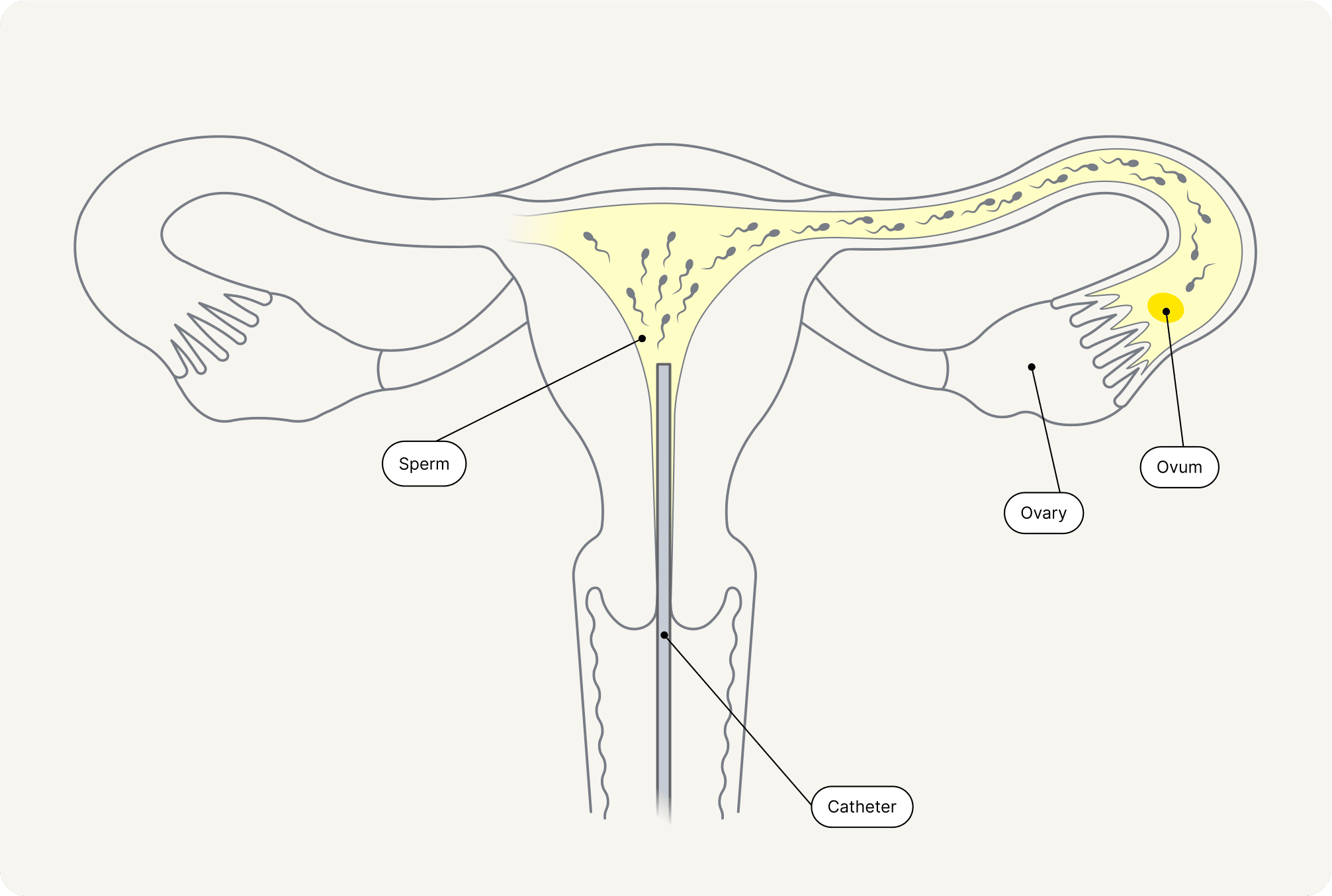Struggling to conceive? Insemination may be a simpler solution than IVF. Learn about the types, process, success rates and who it's for.
Key Facts
- Insemination is a relatively simple and less invasive procedure compared to IVF or ICSI
- It is often recommended as the initial choice for couples with unexplained fertility
- The success rate for one insemination cycle is 10-20%
- Insemination might be an option for same-sex female couples or those who choose donor sperm
- Insemination can be carried out with or without prior hormonal stimulation
Modern medicine provides a variety of assisted reproduction options for couples wishing to have children but are struggling to conceive naturally. The solution doesn't always have to be in vitro fertilisation (IVF) or intracytoplasmic sperm injection (ICSI). In some cases, artificial insemination, also known as intrauterine insemination (IUI), may be an option. This method is relatively simple and less invasive, often recommended as the initial choice for couples with limited fertility.
This article will explore the different types of insemination, how they work and the conditions under which it can be performed.
What Is Insemination?
Insemination, also known as IUI, is the process of transferring prepared sperm into a woman's uterus during ovulation. This procedure brings the sperm closer to the egg, thereby increasing the chances of fertilisation.
Insemination can be performed during a spontaneous cycle or in conjunction with hormone treatment to stimulate the ovaries and promote egg maturation. It is essential to strictly control this process to ensure that not too many follicles grow, minimising the risk of multiple births.
How Does Insemination Work?
Insemination is performed at a fertility centre. A few hours prior to the procedure, the male partner provides a sperm sample that is then prepared in the laboratory. If donor sperm is being used, it is already prepared when thawed. The sperm is then gently transferred into the woman's uterus using a thin catheter.
Step 1 - Determining Ovulation
Before the procedure, the woman's cycle is closely monitored to identify the best time for insemination. This usually aligns with ovulation to enhance the probability of successful fertilisation. Ovulation can occur naturally or be induced by medication.
Step 2 - Sperm Collection and Preparation
The sperm can either come from the woman’s partner (homologous insemination) or a sperm donor (heterologous insemination). The partner’s sperm is collected via ejaculation just before the transfer. It is then washed and processed to enhance sperm motility and concentration. In contrast, donor sperm is thawed before being transferred.
Step 3 - Sperm Transfer (Insemination)
The actual insemination is an outpatient procedure at the fertility centre and is painless. A thin catheter is used to insert the prepared sperm directly into the uterus. The process takes only a few minutes and typically causes only minimal discomfort.

Step 4 - Pregnancy Test
Two weeks post-insemination, a blood test is conducted to check if the insemination was successful. If beta-hCG is detected in the blood, it indicates pregnancy.
What Is The Success Rate Of Insemination?
The success rates of insemination vary based on factors such as the woman's age, the cause of infertility and the quality of the sperm. Studies have shown that the success rate per cycle is around 10-20%, although it may take several attempts to achieve pregnancy.
One article that studied 349 women and 1,005 insemination cycles found that 29.2% of patients became pregnant after one insemination. The pregnancy rate per cycle was 9.4-11.7 % in the first four cycles, after which it decreased. Besides the woman's age, the pregnancy rate was strongly influenced by the partner's sperm parameters. The likelihood of pregnancy decreased if the sperm concentration in the semen analysis was less than 20 million/ml, if less than 5% of the sperm had normal morphology, and if less than 50% of the sperm in the ejaculate were motile.
What Are The Requirements For Insemination?
For insemination, the following prerequisites should be met:
- The woman's fallopian tubes must be open.
- The woman must have ovulated, either naturally or through hormonal stimulation.
- The sperm count should be only slightly reduced.
Insemination may be suggested for couples with minor fertility issues or for lesbian couples, in cases such as:
- A low sperm count or subpar sperm motility.
- Non-specific female infertility where no clear reasons for infertility are identified.
- Problems with cervical mucus that obstruct the sperm's pathway to the uterus.
- Couples choosing heterologous insemination, where donor sperm is used.
It's crucial to remember that the appropriateness for insemination relies on various factors. It should be determined individually by a specialist in reproductive medicine.
Frequently Asked Questions
What types of insemination are available?
There are primarily four types of insemination, each differing by the location where the sperm is injected.
IUI (Intrauterine Insemination)
IUI involves the targeted placement of prepared sperm directly into a woman's uterine cavity. The sperm is specially prepared to enhance its quality and concentration, thus shortening its journey to the egg and increasing the chances of successful fertilisation. IUI is typically performed during ovulation to maximise the chances of pregnancy.
ITI (Intratubal Insemination)
In contrast to IUI, in ITI, the processed sperm is inserted into a woman's fallopian tubes. This less-frequently-used procedure is performed near the fallopian tubes to allow direct fertilisation of the egg within the tubes. ITI is usually used when IUI has been unsuccessful or when specific medical conditions necessitate a more direct fertilisation method.
ICI (Intracervical Insemination)
In ICI, the processed sperm is inserted into the woman's cervix. Unlike IUI or ITI, the sperm is not placed directly into the uterus or fallopian tubes, but closer to the cervix. This method is more commonly used for home inseminations and does not usually require a visit to a medical facility.
Cap Insemination
Cap insemination is not performed in a fertility clinic but is also more suitable for use at home. The sperm is transferred into an insemination cap or a menstrual cup and placed in front of the cervix.
Can I proceed with insemination if I have a poor semen analysis?
The quality and motility of the sperm are critical for successful insemination. If the values of your initial semen sample are outside the normal range, it's recommended to have a second semen analysis conducted after a period of time. This follow-up test can better determine if the quality of your sperm is adequate for insemination.
What are the risks of insemination?
Like any medical procedure, insemination carries certain risks. These can include minor vaginal bleeding, infections, and a low chance of multiple pregnancies. If hormonal stimulation was used to stimulate egg growth, ovarian hyperstimulation syndrome (OHSS) could also occur.
What are the legal considerations for insemination in Switzerland?
In Switzerland, insemination is typically pursued by individuals in stable partnerships. Sperm donation is generally permitted, with the stipulation that the donation from a sperm bank is intended for a married couple. With the introduction of same-sex marriage, this right has been extended to gay or lesbian couples. If a couple opts for sperm donation, the donor must consent to the insemination. The child conceived through this method has the right to access data regarding their biological parent. However, single women in Switzerland currently do not have the option to undergo insemination using sperm donation.
Takeaway
An unfulfilled desire to have children can be very challenging for both partners. If you've been unable to conceive a child, insemination may be a viable treatment option. The key prerequisites for this procedure are patent fallopian tubes, regular ovulation and sperm values that are mostly within the normal range or only have minimal limitations.
If you're considering insemination as an option, feel free to reach out to our compassionate fertility experts at any time.








